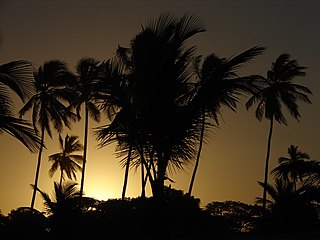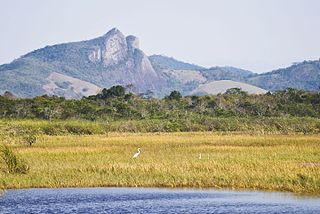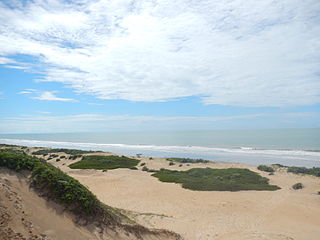Location
The Serra do Conduru State Park is divided between the municipalities of Uruçuca (44%), Itacaré (41%) and Ilhéus (15%) in Bahia. It has an area of 9,275 hectares (22,920 acres). The buffer zone covers 25,057 hectares (61,920 acres). The park is in the eastern hydrographic basin of Bahia. It includes the Lagoa Encantada, the village of Serra Grande, the Itacaré Forest and the mountainous coastline. Human activities include extreme sports, adventure tourism, mountaineering, trekking, mountain biking and ecotourism. Threats include illegal logging and poaching, and delays in regularization of land ownership.
Environment
The average annual temperature is 23 °C (73 °F), with a super-humid tropical climate. The park contains the headwaters of 30 rivers and streams.
The park is in the Atlantic Forest biome and consists of dense submontane rainforest in various stages of succession. Vegetation includes many clearings for agriculture or pasture and fragments of forest in different stages of regeneration. The vegetation is always green, and includes trees up to 40 metres (130 ft) in height as well as dense shrub growth of ferns, arborescents, bromeliads, palms, vines, orchids and cactuses. The wetlands that have not been disturbed by people hold fig trees, palm trees and palmettos. There are as many as 458 tree species per hectare, a very high rate of biodiversity. About 72% of species are typical of the Amazon Forest.
175 bird species have been identified, including 27 that are endemic and six that are threatened. They include red-billed curassow (Crax blumenbachii), red-browed amazon (Amazona rhodocorytha) and ochre-marked parakeet (Pyrrhura cruentata). 9 species of small mammals have been recorded and 30 species of medium or large mammals. These include golden-headed lion tamarin (Leontopithecus chrysomelas), golden-bellied capuchin (Sapajus xanthosternos), cougar (Puma concolor), ocelot (Leopardus pardalis) and coastal black-handed titi (Callicebus melanochir). At least 45 species of endemic amphibians with limited distribution have been identified, including Hylomantis áspera, Eleutherodactylus bilineatus, Cycloramphus migueli and Hyla sibilata.
History
The campaign to create the Serra do Conduru State Park began in 1993, and was promoted in 1996 by Conservation International Brazil, the SOS Atlantic Forest Foundation and the Institute of Social and Environmental Studies of Southern Bahia (IESB). The park was formally created by 6.227 of 21 February 1997. In 1998 highway BA-001 from Ilhéus to Itacaré was inaugurated, prompting studies on land regularization and closing the sawmills in southern Bahia that threatened the ancient trees of the region. It became part of the Central Atlantic Forest Ecological Corridor, created in 2002.
Decree 8.702 of 4 November 2003 expanded the size of the park. The composition of the park's management board was agreed in November 2010. By 2011 the park had formal tenure over 51% of the land, but was still vulnerable due to lack of infrastructure for protecting the land and allowing public use.

Ilhéus is a major city located in the southern coastal region of Bahia, Brazil, 211 km south of Salvador, the state's capital. The city was founded in 1534 as Vila de São Jorge dos Ilhéus and is known as one of the most important tourism centers of the northeast of Brazil.

Itacaré is a municipality in the cocoa zone of the state of Bahia in Brazil, south of Salvador.

Caparaó National Park is a national park created in 1961 to protect the Caparaó Mountains, located on the border between Minas Gerais and Espírito Santo states in Brazil. Pico da Bandeira, one of the highest mountains in Brazil, is located there.

Pedra Azul State Park is a state park in the state of Espírito Santo, Brazil. Law 4,503 of January 2, 1991, transformed the reserve into Pedra Azul State Park, with an area of 1,240 hectares. The predominant biome of this Brazilian conservation unit is dense antimontane rainforest.
Pau Brasil National Park is a national park in the state of Bahia, Brazil. It preserves a remnant of the Atlantic Forest biome.

Uruçuca is a municipality in the state of Bahia in the North-East region of Brazil.

Monte Pascoal National Park is a national park in the state of Bahia, Brazil.

The Descobrimento National Park is a national park in the state of Bahia, Brazil.
The Serra das Lontras National Park (Portuguese: Parque Nacional da Serra das Lontras is a national park in the state of Bahia, Brazil. It protects a rugged area of Atlantic Rainforest with a wide range of bird species, including several that are threatened with extinction.

The Central Atlantic Forest Ecological Corridor (Portuguese: Corredor Central da Mata Atlântica is an ecological corridor in the states of Espírito Santo and Bahia, Brazil. It promotes improvements to connectivity between fragments of Atlantic Forest in the region with the goal of maintaining genetic health among flora and fauna. The greater Atlantic Forest is also home to many native endangered or vulnerable species that are endemic to this part of the globe including but not limited too the: Golden lion tamarin, Three-toed sloth, and the Bristle-spined rat. The Central Ecological Corridor is beneficial in connecting hundreds of at-risk populations experiencing reduced gene flow and genetic variation due to deforestation.
The Wenceslau Guimarães Ecological Station is an ecological station in the state of Bahia, Brazil.

The Cachoeira da Fumaça State Park is a state park in the state of Espírito Santo, Brazil, known for a dramatic waterfall. Visitors may swim in the pools.

The Forno Grande State Park is a state park in the state of Espírito Santo, Brazil. It protects an area of Atlantic Forest and the second highest peak in the state.

The Paulo César Vinha State Park is a state park in the state of Espírito Santo, Brazil. It protects an area of dunes, lagoons and marshes along the Atlantic shore.
The Caminhos Ecológicos da Boa Esperança Environmental Protection Area is an environmental protection area in the state of Bahia, Brazil.

The Lagoa Encantada e Rio Almada Environmental Protection Area is an environmental protection area in the state of Bahia, Brazil.

The Itaúnas State Park is a state park in the state of Espírito Santo, Brazil. It protects the lower reaches of the Itaúnas River and a strip of marshes, dunes and beaches along the Atlantic coast of the north of the state.
The Serra das Torres Natural Monument is a natural monument in the state of Espírito Santo, Brazil. It protects the peaks of a mountain range in the south of the state.

The Baía de Camamu Environmental Protection Area is an environmental protection area in the state of Bahia, Brazil. It tries to preserve the natural vegetation of mangroves, restinga and Atlantic Forest around the Camamu Bay.

The Morro do Chapéu State Park Portuguese: Parque Estadual do Morro do Chapéu is a state park in the state of Bahia, Brazil. It protects an area of the caatinga biome that includes interesting geological formations and prehistoric cave paintings. There have been extended delays in physically implementing the park, and an attempt was made in 2011 to cancel it.
This page is based on this
Wikipedia article Text is available under the
CC BY-SA 4.0 license; additional terms may apply.
Images, videos and audio are available under their respective licenses.
















